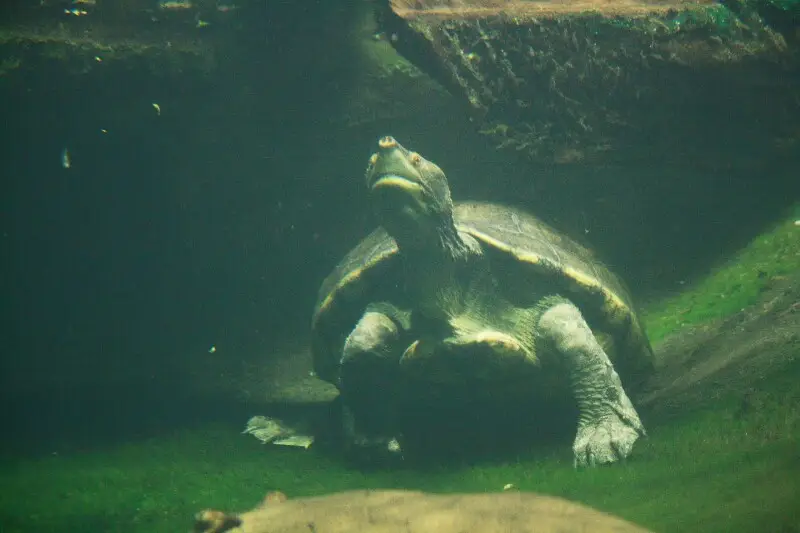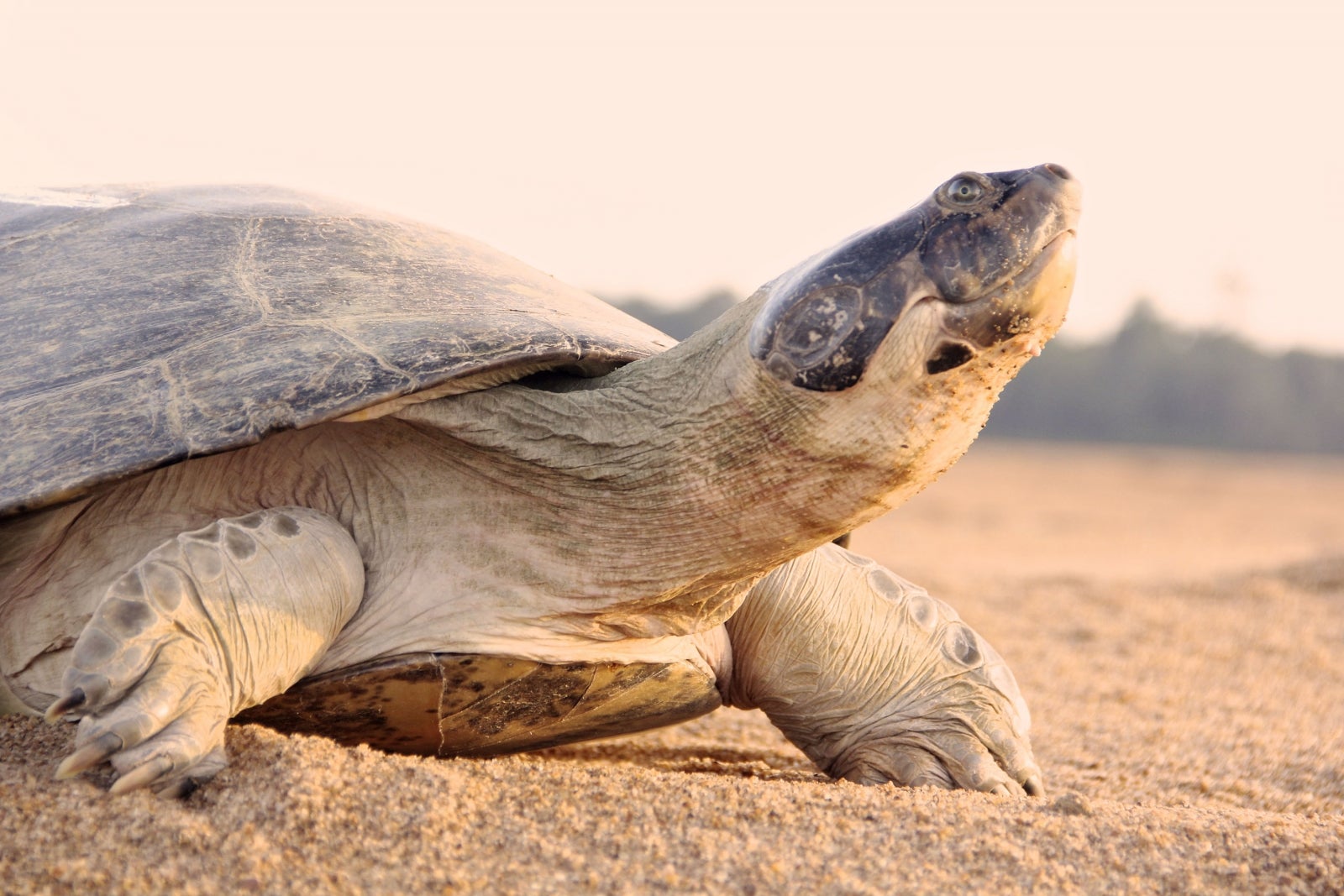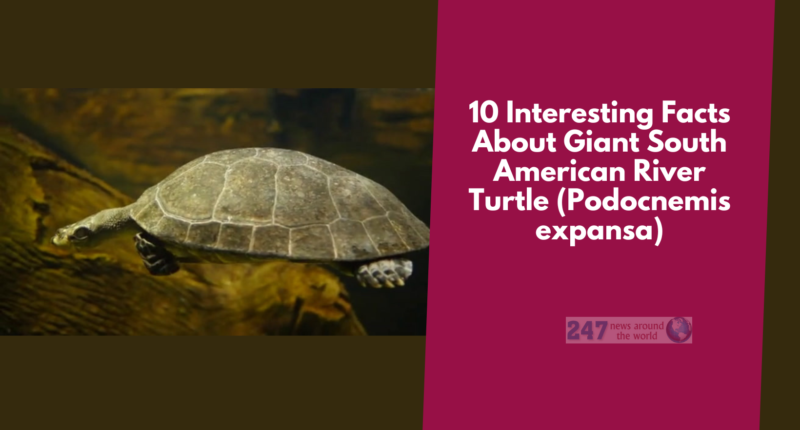Find out “10 Interesting Facts About Giant South American River Turtle” The Giant South American River Turtle, scientifically known as Podocnemis expansa, is an incredible species that inhabit the rivers and lakes of South America. With its unique characteristics and intriguing behaviors, this turtle has fascinated researchers and wildlife enthusiasts alike.
In this article, we will explore (10) ten interesting facts about the Giant South American River Turtle, shedding light on its habitat, physical traits, nesting behavior, conservation status, and more.
10 Interesting Facts About Giant South American River Turtle (Podocnemis expansa)
The Giant South American River Turtle, also known as Podocnemis expansa, is a fascinating species that inhabits the rivers and lakes of South America. Its large size, unique physical characteristics, and captivating behaviors make it a subject of great interest and study. From its habitat and nesting behavior to its diet and cultural significance, there is much to learn and appreciate about these incredible turtles.

It is crucial to recognize the conservation challenges that the Giant South American River Turtle faces. Habitat destruction, pollution, and overexploitation have taken a toll on their populations, leading to their vulnerable status. It is our responsibility to protect their habitats, promote sustainable practices, and raise awareness about the importance of conserving these remarkable creatures.
By taking action and supporting conservation efforts, we can help ensure the survival and well-being of the Giant South American River Turtle. Through research, education, and collaboration, we can contribute to the preservation of this species and the biodiversity of the South American river systems they call home.
Habitat and Distribution
The Giant South American River Turtle primarily resides in the vast river systems of South America, including the Amazon and Orinoco basins. These turtles prefer slow-moving rivers, flooded forests, and oxbow lakes as their habitat. The warm tropical climate and abundant vegetation in these areas provide them with ideal living conditions.
Physical Characteristics
One remarkable feature of this turtle is its large size, making it one of the largest freshwater turtles in the world. Adult individuals can reach impressive lengths of over three feet and weigh up to 200 pounds. They have a streamlined shape, a broad head, and powerful flippers that aid in swimming through the water with agility.
Lifespan and Reproduction
The Giant South American River Turtle has a relatively long lifespan, with individuals living up to 70 years in the wild. These turtles reach sexual maturity at around 10 to 20 years of age. During the breeding season, females migrate to sandy riverbanks to lay their eggs, often returning to the same nesting site year after year.
Nesting Behavior
Female Giant South American River Turtles display fascinating nesting behavior. They dig large nests in the sand and lay a considerable number of eggs, sometimes exceeding 100. After carefully covering the nest, the female returns to the water, leaving the eggs to hatch on their own. The temperature of the nest determines the $ex of the hatchlings, with warmer temperatures producing females and cooler temperatures resulting in males.
Diet and Feeding Habits
These turtles are primarily herbivorous, feeding on a variety of plant material found in their aquatic environment. They consume fruits, leaves, flowers, and even aquatic vegetation. However, juveniles and young individuals may also include small invertebrates and insects in their diet, gradually transitioning to a predominantly herbivorous diet as they grow older.
Importance in Ecosystem
The Giant South American River Turtle plays a vital role in its ecosystem. As herbivores, they contribute to the dispersal of seeds and help maintain the balance of aquatic plant communities. Additionally, their nesting activities create nesting sites for other species, supporting the overall biodiversity of the region.
Threats and Conservation Status
Unfortunately, these fascinating creatures face numerous threats in their natural habitat. Habitat destruction, pollution, illegal egg collection, and hunting for their meat and shells have significantly impacted their populations. As a result, the Giant South American River Turtle is listed as vulnerable by the International Union for Conservation of Nature (IUCN).
Cultural Significance
The Giant South American River Turtle holds great cultural significance in the regions where it is found. Indigenous communities have long revered these turtles and consider them symbols of fertility, wisdom, and longevity. They are often incorporated into traditional folklore and rituals, highlighting the deep connection between humans and nature.
Captivating Behavior
The behavior of the Giant South American River Turtle is truly captivating. One intriguing aspect is their ability to communicate with each other underwater through a series of vocalizations, including grunts and hisses. These sounds are believed to serve various purposes, such as defending territory and attracting mates.
Another fascinating behavior is their communal nesting. Females often gather in large groups, known as arribadas, to lay their eggs simultaneously. This synchronized nesting behavior provides them with additional protection against predators and increases the chances of successful egg incubation.
Children Fun Facts Giant South American River Turtle (Podocnemis expansa)
Here are some fun facts about the Giant South American River Turtle (Podocnemis expansa) that children would enjoy:
- Size and Weight: The Giant South American River Turtle is one of the largest freshwater turtles in the world. It can grow up to three feet long and weigh as much as 200 pounds. That’s like having a turtle as big as a small car!
- Shell Design: The turtle’s shell, called a carapace, is made up of many bony plates called scutes. These scutes have a unique pattern that helps to protect the turtle and provide camouflage in the water.
- Aquatic Adaptations: The Giant South American River Turtle has webbed feet and powerful flippers, which make it an excellent swimmer. It can glide through the water with ease and grace, just like a fish.
- Herbivorous Diet: These turtles are herbivores, which means they eat only plants. Their favorite foods include fruits, leaves, flowers, and aquatic vegetation. They help keep the ecosystem in balance by spreading seeds as they eat.
- Long Lifespan: Giant South American River Turtles can live for a very long time. Some individuals have been known to live up to 70 years in the wild. That’s older than most people’s grandparents!
- Nesting Rituals: Female turtles have a special nesting behavior. They gather in large groups called arribadas and come ashore together to lay their eggs. It’s like a big turtle party on the beach!
- Temperature Determines Gender: The temperature of the nest determines the gender of the baby turtles. Warmer temperatures produce more females, while cooler temperatures result in more males. Nature has its own way of balancing things out!
- Vulnerable Status: Unfortunately, Giant South American River Turtles are facing threats to their survival. Habitat destruction, pollution, and hunting for their meat and shells have caused their populations to decline. It’s important for us to protect these amazing creatures and their homes.
- Cultural Significance: These turtles hold great cultural significance in the regions where they are found. Indigenous communities see them as symbols of wisdom and longevity, and they are often featured in local folklore and traditions.
- Conservation Heroes: By learning about these turtles and spreading awareness, children can become conservation heroes. They can help protect the Giant South American River Turtles and their habitats by supporting conservation organizations and practicing environmental stewardship.
Remember, it’s our responsibility to care for and protect the incredible wildlife around us, including the amazing Giant South American River Turtle. Let’s celebrate their uniqueness and work together to ensure their survival for future generations to enjoy.
Conclusion

In conclusion, the Giant South American River Turtle, with its impressive size, unique characteristics, and intriguing behaviors, is a remarkable species that enriches the biodiversity of South America’s river systems. From their large size and herbivorous diet to their nesting habits and cultural significance, these turtles have captivated the attention of researchers and conservationists worldwide.
However, the Giant South American River Turtle faces numerous threats, highlighting the urgent need for conservation efforts. Protecting their habitats, implementing sustainable practices, and raising awareness about their importance are crucial steps in ensuring the survival of this magnificent species for generations to come.
FAQs
- Are Giant South American River Turtles endangered? Yes, they are considered vulnerable according to the IUCN Red List of Threatened Species.
- What is the average size of an adult Giant South American River Turtle? Adult individuals can grow to over three feet in length and weigh up to 200 pounds.
- How long do Giant South American River Turtles live? They can live up to 70 years in the wild.
- Do these turtles migrate for nesting purposes? Yes, female turtles migrate to sandy riverbanks to lay their eggs.
- What do Giant South American River Turtles eat? They primarily consume plants, including fruits, leaves, flowers, and aquatic vegetation.
See Also | South American Tapir: The Amazon’s Large Herbivore







